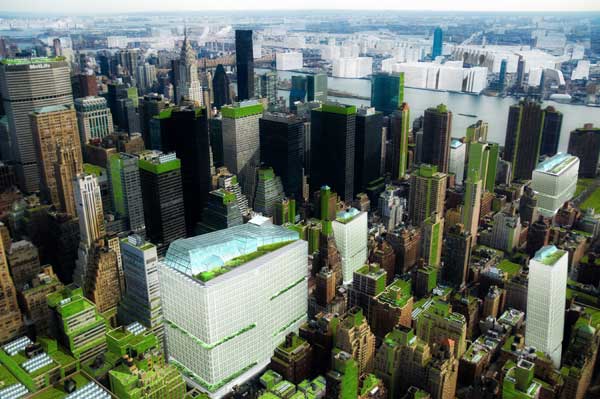

The plan for a self-sufficient New York City includes skyscraper farms and a mix of advanced and traditional growing techniques to feed the city’s 8.3 million residents, but will it ever come to fruition? Credit: Terreform
What would New York City (home to some of the world’s tallest and newest skyscrapers) look like if its steely skyline was suddenly green?
It’s what New York architect Michael Sorkin, who founded and leads Terreform, a center of “advanced urban research,” has been contemplating for the last six years.
“The planet is going to hell in a hand basket,” Sorkin writes in Aeon Magazine. “Population grows exponentially, the air is toxic, and there simply aren’t enough resources to go around. The Earth could not sustain even a third of its current population were we all to consume at American levels. This fundamental gap succinctly describes the environmental ‘crisis’ for what it is: a problem of equity.”
Sorkin’s solution to this problem of equity? A plan called New York City (Steady) State, which, according to the Terreform website, seeks to answer one big question: Is a self-sufficient NYC (i.e., a city that supports itself and its 8.3 million residents—everything from energy and food supply, to construction, manufacturing, and waste—within its own geographical and political boundaries) possible?
The answer isn’t a simple yes or no, with the Terreform team noting that sustainability, like just about everything else in life, has its limits. Rather, their response is a “cradle-to-cradle” repurposing of the Big Apple—a collection of ideas that could transform cities of similar size and take “going green” to the next level.
So what does Terreform’s self-sufficient city look like?
It’s green. Really green. Nearly every building in Manhattan sports a green roof, and vertical skyscraper farms (farming towers in “found spaces” around the city, including “food hubs” constructed atop subway lines for easier and streamlined food delivery) each have the capacity to grow food for approximately 12,000 people. They also include outdoor spaces for livestock.

The construction of vertical skyscraper farms on found spaces throughout the city produce enough food to feed NYC’s 8.3 million residents. Credit: Terreform.

Streamlined food delivery includes the construction of farming towers atop existing train lines. Credit: Terreform.
It’s got less traffic. A “rapid transit station” helps minimize car and taxi travel on NYC’s notoriously gridlocked city streets, and community gardens replace concrete roads (up to 50 percent of all surface streets) in various areas of the city.
It’s heavily (though, perhaps begrudgingly) reliant on nuclear. Nuclear has been a big part of the push for clean energy. But it’s also controversial. Terreform’s self-sustaining NYC would be able to produce 2,500 nutritious calories for each New York resident each day—but would heavily rely on the ability to produce nuclear energy and a lot of it. “At one level, the required infrastructure is not entirely outlandish,” Sorkin writes in the Aeon article. “It would depend on the widespread use of vertical farming, building over existing infrastructure—railways, highways, factories, etc—and the densification of some parts of the city currently built at suburban scale. The cost, however, would be prodigious and many of the implications highly vexed. For example, the energy required to light, heat, and build all of this is, we’ve calculated, approximately equivalent to the output of 25 nuclear power plants, an eventuality that is, to put it mildly, somewhat at odds with our larger intentions. Likewise, the necessarily [industrialized] character of such production would beg the question of resisting the tender mercies of agri-business and the huge variety of its downside effects.”

To produce enough nutritious calories for each NYC resident, more than 25 nuclear power plants would be needed. Credit: Terreform.
It’s a self-described “thought-experiment” that may never “grow” anywhere. A Huffington Post piece says the “tremendously ambitious plan remains a pipe dream.” And while “pipe dreams” tend to have a negative connotation, in this case, a pipe dream may be better than no dream at all. According to Terreform, rather than a hard-and-fast master plan, New York City (Steady) State is an “inventory of best practices that are relevant to cities around the world.”
“We looked at 100 [percent] autonomy—what effort that would take, what forms, what living arrangements—and we then look for some more reasonable response,” Sorkin says in a Co.Exist report.
What do you think? Would the Terreform model take flight or make a crash landing?
Before you respond, take a minute to read this “vintage” article on a collaborative effort between the urban research nonprofit and MIT to prove treehouses aren’t just for kids.
Author
Jessica McMathis
CTT Categories
- Construction
- Energy
- Environment
- Manufacturing




